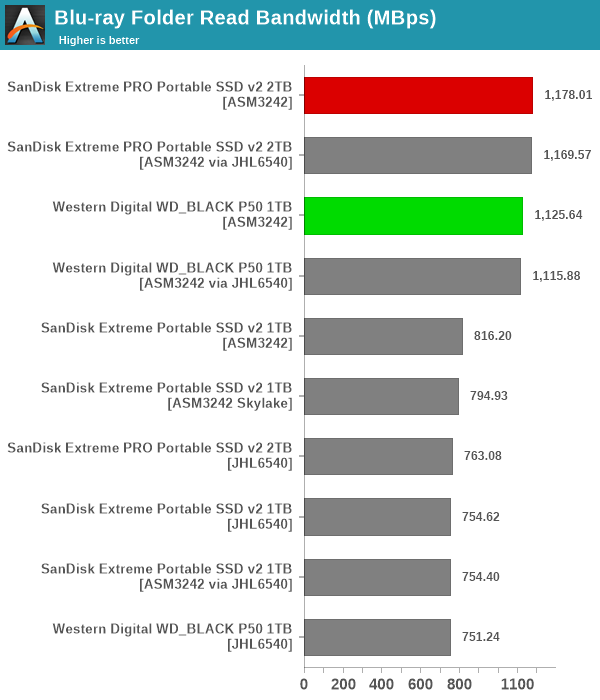USB 3.2 Gen 2x2 State of the Ecosystem Review: Where Does 20Gbps USB Stand in 2020?
by Ganesh T S on October 5, 2020 10:30 AM EST- Posted in
- Storage
- SSDs
- Western Digital
- SanDisk
- ASMedia
- USB 3.2 Gen 2x2
AnandTech DAS Suite - Benchmarking for Performance Consistency
Our testing methodology for DAS units takes into consideration the usual use-case for such devices. The most common usage scenario is transfer of large amounts of photos and videos to and from the unit. Other usage scenarios include the use of the DAS as a download or install location for games and importing files directly off the DAS into a multimedia editing program such as Adobe Photoshop. Some users may even opt to boot an OS off an external storage device.
The AnandTech DAS Suite tackles the first use-case. The evaluation involves processing three different workloads:
- Photos: 15.6 GB collection of 4320 photos (RAW as well as JPEGs) in 61 sub-folders
- Videos: 16.1 GB collection of 244 videos (MP4 as well as MOVs) in 6 sub-folders
- BR: 10.7 GB Blu-ray folder structure of the IDT Benchmark Blu-ray
Each workload's data set is first placed in a 25GB RAM drive, and a robocopy command is issued to transfer it to the DAS under test (formatted in NTFS). Upon completion of the transfer (write test), the contents from the DAS are read back into the RAM drive (read test). This process is repeated three times for each workload. Read and write speeds, as well as the time taken to complete each pass are recorded. Bandwidth for each data set is computed as the average of all three passes.

The write workloads see the Extreme PRO v2 come out slightly better than the WD_BLACK P50 using the Haswell testbed. On the reads, we see the Hades Canyon / eGFX enclosure turning out to be better - this can be attributed in part to the capabilities of the testbed itself, rather than the PCIe tunneling chain. In any case, we don't see any significant gulf in the numbers between the different units as long as the observations are made within the USB SuperSpeed 10Gbps or USB SuperSpeed 20Gbps host configurations.We also instrumented our evaluation scheme for determining performance consistency.
Performance Consistency
Aspects influencing the performance consistency include SLC caching and thermal throttling / firmware caps on access rates to avoid overheating. This is important for power users, as the last thing that they want to see when copying over 100s of GB of data is the transfer rate going down to USB 2.0 speeds.
In addition to tracking the instantaneous read and write speeds of the DAS when processing the AnandTech DAS Suite, the temperature of the drive was also recorded at the beginning and end of the processing. In earlier reviews, we used to track the temperature all through. However, we have observed that SMART read-outs for the temperature in NVMe SSDs using bridge chips end up negatively affecting the actual transfer rates. To avoid this problem, we have restricted ourselves to recording the temperature at either end of the actual workloads set. The graphs below present the recorded data.
| Performance Consistency and Thermal Characteristics |
 |
The first three sets of writes and reads correspond to the photos suite. A small gap (for the transfer of the video suite from the internal SSD to the RAM drive) is followed by three sets for the video suite. Another small RAM-drive transfer gap is followed by three sets for the Blu-ray folder. An important point to note here is that each of the first three blue and green areas correspond to 15.6 GB of writes and reads respectively. There is no issue with thermal throttling - even in the fastest configuration, both the P50 and Extreme PRO v2 show an increase of less than 5C after the workload processing. The P50 seems to have slightly better thermal performance for this workload set.










81 Comments
View All Comments
vol.2 - Monday, October 5, 2020 - link
So wait for USB4 devices then?
boredsysadmin - Monday, October 5, 2020 - link
No, USB 3.3 Rev 2 Gen 5 10.13 Finalvol.2 - Monday, October 5, 2020 - link
So USB4 will be gimped to 10gb rates for USB4 devices? Regardless, what makes you say 3.3, etc?magreen - Monday, October 5, 2020 - link
He's joking. Poking fun at the ridiculous (re)naming conventions of the USB-IFGuspaz - Monday, October 5, 2020 - link
It's like they're determined to intentionally come up with the most obtuse and confusing naming conventions possible. Which is how you end up with a situation where USB 3.0 == USB 3.1 Gen 1 == USB 3.2 Gen 1x1 == SuperSpeed USB 5Gbps, because having four different names for exactly the same thing is obviously the right approach.BikeDude - Tuesday, October 6, 2020 - link
Screw you guys.I'm sticking with USB _Full_ Speed. That is the fastest of them all. Full speed ahead!
Oh...wait...
Alistair - Tuesday, March 23, 2021 - link
it's a year later, and I'm still laughing so hard at this thread :)throAU - Sunday, October 11, 2020 - link
This is no accident. The USB consortium is run by PC vendors who want to be able to call their crappy old widget from last year USB 3.2 without any hardware change, and hide the fact that it is old and slow in the fine print.throAU - Sunday, October 11, 2020 - link
USB 4.1 Gen 1 will probably still be 5 gigabitHuzzam - Wednesday, October 14, 2020 - link
no way man, i'm sticking with USB 3.3. Rev 2 Gen 5 10.12 beta... so called "final" causes covid and gayness, one of which is really bad